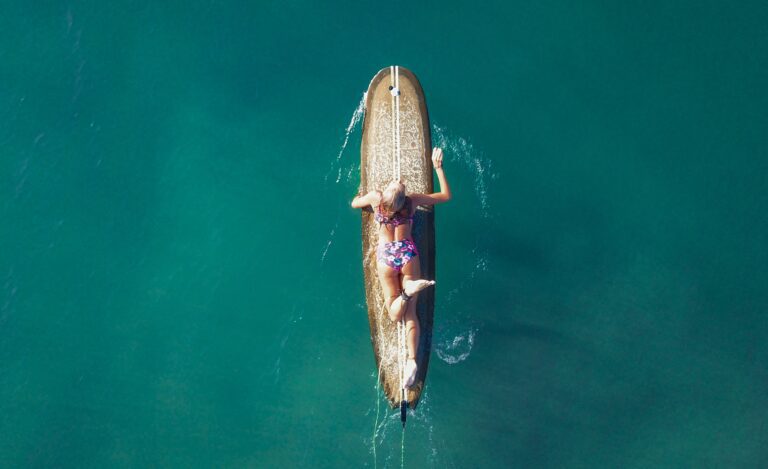Introduction
Join us on a journey that harmonizes the adrenaline rush of surfing with the vibrant canvas of indigenous artistry along coastal communities. Coastal regions not only provide incredible waves for surfers but also serve as cradles of diverse indigenous cultures. This article celebrates the fusion of surfing and indigenous art, delving into how these two elements intertwine, embodying the spirit and heritage of coastal communities around the world.
The Rich Artistic Traditions of Indigenous Coastal Cultures
The artistic heritage of indigenous coastal communities resonates with a depth of cultural expression that spans generations. These vibrant cultures are renowned for their diverse and intricate art forms, each carrying a unique story and heritage.
Traditional Art Forms: Carvings, Paintings, and Textiles
Carvings: Carving holds a significant place in the artistic repertoire of coastal indigenous communities. Intricately carved totem poles, masks, and sculptures crafted from wood or stone reflect tales of ancestry, spiritual beliefs, and societal customs. Each carving is a testament to the skilled craftsmanship passed down through oral traditions.
Paintings: Indigenous coastal art often incorporates paintings that depict scenes from mythology, nature, or daily life. These paintings, executed on various mediums like bark, rocks, or canvas, showcase vivid colors and intricate patterns, revealing the intimate connection these communities hold with their environment.
Textiles: Textiles form another cornerstone of indigenous artistic expression. Woven fabrics, adorned with symbolic motifs and natural dyes, narrate stories of heritage and identity. From intricately woven blankets to garments showcasing traditional designs, these textiles are a testament to the weaving skills and cultural pride of these communities.
Cultural Significance and Symbolism in Indigenous Art
Indigenous art is steeped in cultural significance and symbolism, serving as a visual language that communicates traditions, beliefs, and values. Each motif, color, or pattern holds profound meaning, often representing elements of nature, ancestral spirits, or social hierarchies.
Symbolism: For instance, specific animal motifs may symbolize strength, wisdom, or a connection to the spiritual realm. Geometric patterns might depict the interconnectedness of all living beings or represent ancestral stories passed through generations.
Cultural Significance: Art serves as a bridge between the past and present, preserving cultural identity and fostering community cohesion. Through art, indigenous coastal communities honor their ancestors, celebrate their heritage, and assert their presence in a rapidly changing world.
Exploring the artistic heritage of these indigenous coastal cultures unveils a world of mesmerizing creativity, intricate symbolism, and a profound connection to nature and tradition. It’s a testament to the resilience and cultural richness of these communities that continue to inspire awe and admiration worldwide.

Surfing and Cultural Identity
Surfing transcends being merely a sport; it’s deeply woven into the fabric of coastal communities, reflecting their cultural identity. Coastal societies worldwide, from Hawaii to Polynesia, have revered surfing not just as a pastime but as a profound expression of their heritage. It’s a way of life, a connection to the ocean, and a cultural marker passed down through generations.
Indigenous Art on Surfboards and Artifacts
Surfboards serve as more than just tools for riding waves; they are canvases for indigenous art, embodying stories, traditions, and cultural symbols. Communities infuse surfboards and related artifacts with intricate designs, vibrant colors, and indigenous motifs that represent their history, mythology, and connection to the sea. These designs often convey tales of ancestry, spiritual beliefs, and the profound relationship between humans and nature.
Surfing as Storytelling and Cultural Preservation
Surfing is an art form in itself, becoming a medium for storytelling and cultural preservation. Through the act of riding waves, surfers transmit narratives embedded in their communities. Whether through dance-like movements on the waves or the communal rituals surrounding the sport, surfing encapsulates the essence of cultural heritage. Indigenous communities utilize surfing as a means to preserve their traditions, passing down knowledge and values from one generation to the next.
Surfing competitions and gatherings often incorporate cultural rituals, music, and art, becoming platforms where traditions thrive and evolve. The resurgence of interest in traditional surfing techniques and the integration of indigenous art into modern surf culture underscore the vital role surfing plays in preserving cultural identity.
Surfing isn’t just about riding waves; it’s a vehicle for communities to celebrate their heritage, share their stories, and uphold their cultural legacy. It’s a symbiotic relationship between people and the sea, intertwining tradition, art, and identity in the exhilarating dance atop ocean swells.



